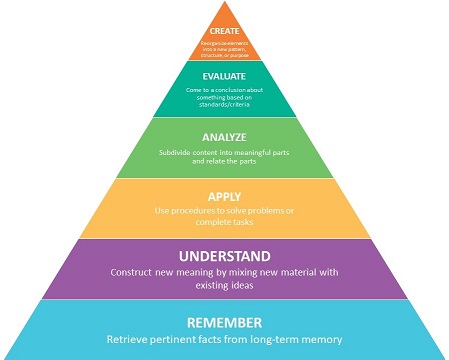Learning Outcomes & Bloom's Taxonomy
Learning Outcomes
Over all, learning outcomes:
- Allow us to demonstrate that learning has occurred in our students in an objective, measurable way
- Focus on learning and student success, supporting the university mission and provost charge
- Are an integral part of accreditation standards
- Empower students to become more involved with their learning experiences
- Allow us to assess students' learning and use the results as a tool for improvement
- Create a common language that crosses all departments within a university
Learning outcomes demonstrate what you want students to know, do, or value by the end of your course. A typical learning outcome may start with "By the end of this course, students will be able to…" Then, continue the sentence with an action verb and a goal for the course. When writing learning outcomes, Bloom's Taxonomy (described below) can be a helpful tool to choose action verbs that reflect the appropriate level of rigor intended for the course.
Tips for constructing learning outcomes:
- Focus on outcomes, not processes
- Start each outcome with an action verb
- Avoid vague verbs such as know and understand
- Incorporate a mixture of lower-order and higher-order thinking
- Write the outcomes from the student perspective
- Check that the outcomes reflect knowledge, skills, or attitudes
- Try for no more than three outcomes per major topic
Bloom's Taxonomies
Bloom's Taxonomy is a tool to help you to assess the level of rigor and challenge your students are experiencing in your course. To consciously and intentionally address the level of cognitive complexity and challenge in a course, Bloom's Taxonomy is an excellent framework, providing multiple points of entry.
Cognitive Domain
The cognitive domain concerns knowledge (remembering/retaining information) and the development of intellectual skills (synthesis, problem solving, etc.). The different levels of the cognitive domain categorize students' thinking from less to more complex levels of thinking; for example, having students write a paper analyzing the impact of interest rates on the growth of the U.S. economy requires substantially more complex thinking than asking students to state the current interest rate. There are six major categories of cognitive processes, starting from simple to more complex processes:

Instructors can use the six major categories to organize their lesson plans and assignments into varying levels of difficulty, resulting in a course that guides students through increasingly more complex material. Additionally, instructors can use the verbs associated with Bloom's taxonomy to develop clear learning objectives associated with a specific level of difficulty. Building learning objectives using Bloom's cognitive taxonomy can help instructors link learning activities with specific levels of complexity.
This Bloom's Taxonomy resource show the cognitive levels of the pyramid with sample verbs associated with each level for easily creating learning outcomes or exam questions.
Affective Domain
The affective domain demonstrates how new knowledge and learning promotes the growth in a student's feelings or emotions such as values, motivations, and attitudes. Students encounter the world through their affective domain via their values and belief systems: the outward portrayal of the affective domain would be the student's attitude. A student's attitude can have a profound effect on his or her learning. For example, a student may have competency in performing a task, but may not have the desire (attitude). People in general change their attitude in response to various events in life; however, instructors can change a student's affective domain over the course of a class by performance interventions.
- Exposure effect uses simple experiences to form a student's attitude by exposing the student to a positive experience a number of times.
- Reinforcement requires a constant action to promote an effect or instill a good habit. For example, making classrooms safe and non-threatening promotes feelings of security while students are learning.
- Persuasive communication promotes a student internalization of a message by making sure that the source (the instructor) is believable and likeable, the message has appropriate content and style, and is properly tailored to the students' attitudes.
- Changing viewpoints takes your students through the steps of understanding how they initially approach a situation, and how that approach can be broken down to produce a positive emotion.
For more information about the affective domain taxonomy, including examples and key words/verbs for each level, visit Bloom's Taxonomy: Affective Domain.
Psychomotor Domain
The psychomotor domain relates to the physical movement, coordination, and use of motor skills involved in completing a task or learning new material. Students learn how to physically accomplish tasks through the psychomotor domain by applying strategy and practicing performing the actions required. Students improve their skill by choosing and implementing the most efficient strategies to accomplish the task, reviewing the results, and then refining their strategies.
To learn more about the psychomotor domain taxonomy, including examples and key words/verbs for each level, visit Bloom's Taxonomy: Psychomotor Domain.
Resources for Bloom's Taxonomy:
The Bloom's Taxonomy with which you may be familiar (shown above) is actually a version that was revised in 20011 of the original 1959 taxonomy2. To learn more about the revision, see Bloom's Taxonomy Revised.
This 11 minute video created by John Hopkins introduces instructors to using Bloom's Taxonomy to create learning objectives.
1 Anderson, L. W. and Krathwohl, D. R., et al (Eds..) (2001) A Taxonomy for Learning, Teaching, and Assessing: A Revision of Bloom's Taxonomy of Educational Objectives. Allyn & Bacon. Boston, MA: Pearson Education Group.
2 Bloom, B.S. and Krathwohl, D. R. (1956) Taxonomy of Educational Objectives: The Classification of Educational Goals, by a committee of college and university examiners. Handbook I: Cognitive Domain. NY, NY: Longmans, Green.